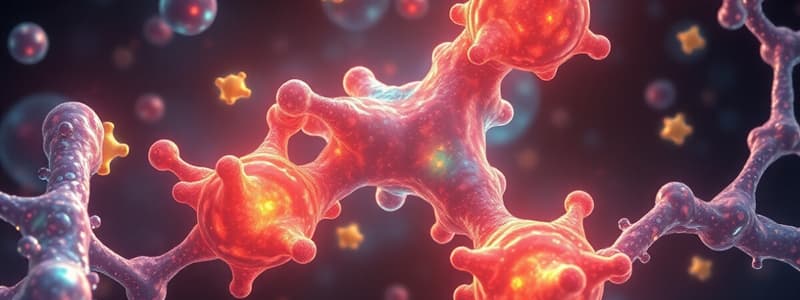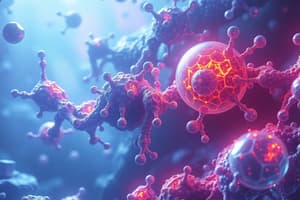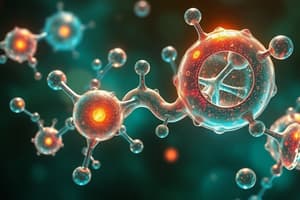Podcast
Questions and Answers
Which statement accurately describes the role of enzymes in biochemical reactions?
Which statement accurately describes the role of enzymes in biochemical reactions?
- Enzymes are completely consumed during the reactions they catalyze.
- Enzymes only work in the digestive system.
- Enzymes accelerate biochemical reactions without being changed themselves. (correct)
- Enzymes change their structure after catalyzing a reaction.
What are isozymes?
What are isozymes?
- Enzymes that are catalyzed by the same substrate.
- Enzymes that differ in amino acid sequence but catalyze the same reaction. (correct)
- Enzymes that are non-proteins acting as catalysts.
- Enzymes that are produced only in the digestive tract.
What is the primary function of the active site of an enzyme?
What is the primary function of the active site of an enzyme?
- To regulate the temperature at which reactions occur.
- To bind the substrate and facilitate the reaction. (correct)
- To store the product of reactions.
- To change the enzyme's structure after binding the substrate.
Which of the following factors can affect enzyme activity?
Which of the following factors can affect enzyme activity?
What is the significance of the 'lock-and-key' model in enzymatic reactions?
What is the significance of the 'lock-and-key' model in enzymatic reactions?
In the context of lactate dehydrogenase, what does the presence of different isozymes indicate?
In the context of lactate dehydrogenase, what does the presence of different isozymes indicate?
What does the binding of a substrate to an enzyme result in?
What does the binding of a substrate to an enzyme result in?
Which class of enzymes is involved in the transfer of functional groups?
Which class of enzymes is involved in the transfer of functional groups?
Which statement correctly describes coenzymes?
Which statement correctly describes coenzymes?
What characteristic primarily determines an enzyme's specificity for its substrate?
What characteristic primarily determines an enzyme's specificity for its substrate?
What term describes an enzyme that lacks its coenzyme?
What term describes an enzyme that lacks its coenzyme?
What is the energy barrier that must be overcome for a reaction to proceed called?
What is the energy barrier that must be overcome for a reaction to proceed called?
How does an increase in ΔG affect reaction velocity?
How does an increase in ΔG affect reaction velocity?
Which factor would likely affect enzyme activity by changing the environment of the enzyme?
Which factor would likely affect enzyme activity by changing the environment of the enzyme?
In what way does lemon juice prevent the browning of sliced apples?
In what way does lemon juice prevent the browning of sliced apples?
Which of the following best describes the maximum rate of an enzyme-catalyzed reaction?
Which of the following best describes the maximum rate of an enzyme-catalyzed reaction?
What happens to the rate of an enzyme-catalyzed reaction as substrate concentration increases?
What happens to the rate of an enzyme-catalyzed reaction as substrate concentration increases?
At what condition is an enzyme considered to be operating at maximum activity?
At what condition is an enzyme considered to be operating at maximum activity?
How does temperature affect the velocity of an enzymatic reaction?
How does temperature affect the velocity of an enzymatic reaction?
What is the relationship between pH and enzyme activity?
What is the relationship between pH and enzyme activity?
What represents the maximum reaction velocity in Michaelis-Menten kinetics?
What represents the maximum reaction velocity in Michaelis-Menten kinetics?
What is KM in the context of Michaelis-Menten kinetics?
What is KM in the context of Michaelis-Menten kinetics?
What occurs when an enzyme becomes saturated with substrate?
What occurs when an enzyme becomes saturated with substrate?
What effect can extreme temperatures have on enzyme activity?
What effect can extreme temperatures have on enzyme activity?
Flashcards
What are enzymes?
What are enzymes?
Biologically active proteins that accelerate chemical reactions within living organisms.
How do enzymes work?
How do enzymes work?
Enzymes are not consumed or changed during the reaction they catalyze. They can be used repeatedly.
What is an active site?
What is an active site?
A specific region on an enzyme where the substrate binds to initiate the catalytic reaction.
What is the lock-and-key model?
What is the lock-and-key model?
Signup and view all the flashcards
What is the induced-fit model?
What is the induced-fit model?
Signup and view all the flashcards
What is a substrate?
What is a substrate?
Signup and view all the flashcards
What are isoenzymes?
What are isoenzymes?
Signup and view all the flashcards
What is a cofactor?
What is a cofactor?
Signup and view all the flashcards
Enzyme Flexibility
Enzyme Flexibility
Signup and view all the flashcards
What are cofactors?
What are cofactors?
Signup and view all the flashcards
Holoenzyme vs Apoenzyme
Holoenzyme vs Apoenzyme
Signup and view all the flashcards
What is the Transition State?
What is the Transition State?
Signup and view all the flashcards
What is Activation Energy?
What is Activation Energy?
Signup and view all the flashcards
What is reaction velocity?
What is reaction velocity?
Signup and view all the flashcards
Factors affecting reaction velocity
Factors affecting reaction velocity
Signup and view all the flashcards
Vmax
Vmax
Signup and view all the flashcards
Km
Km
Signup and view all the flashcards
Steady State
Steady State
Signup and view all the flashcards
Temperature Effect on Enzyme Activity (Increase)
Temperature Effect on Enzyme Activity (Increase)
Signup and view all the flashcards
Temperature Effect on Enzyme Activity (Decrease)
Temperature Effect on Enzyme Activity (Decrease)
Signup and view all the flashcards
pH Effect on Enzyme Activity (Ionization)
pH Effect on Enzyme Activity (Ionization)
Signup and view all the flashcards
pH Effect on Enzyme Activity (Denaturation)
pH Effect on Enzyme Activity (Denaturation)
Signup and view all the flashcards
Michaelis-Menten Kinetics
Michaelis-Menten Kinetics
Signup and view all the flashcards
Study Notes
Enzymes
- Enzymes are biologically active proteins that speed up the breakdown of food.
- Enzymes are biological catalysts; they accelerate reactions without being consumed or altered.
- Enzymes are involved in crucial life processes, including DNA replication, transcription, protein synthesis, metabolism, and signal transduction.
Enzyme Classification and Properties
- The provided document lists topics to be learned including classification of enzymes, their properties, holoenzymes, apoenzymes, cofactors, coenzymes, mechanisms of enzyme action, kinetics of chemical reactions, and factors affecting enzyme activity (substrate concentration, pH, temperature).
- These topics, along with enzyme classes (Oxidoreductases, Transferases, Hydrolases, Lyases, Isomerases, Ligases) are part of a comprehensive study of enzymes.
Active Site
- Enzyme molecules have an active site, a pocket or cleft where substrates bind.
- The active site's shape is crucial for substrate recognition.
- Active sites contain amino acid residues that participate in substrate binding and catalysis.
- Substrate binding to the enzyme forms an enzyme-substrate complex.
Substrate-Binding Sites
- Enzyme specificity, the ability of an enzyme to react with a particular substrate, arises from the precise 3D arrangement of amino acids in the active site.
- The "lock-and-key" and "induced-fit" models describe how substrates bind to enzymes.
Enzyme-Substrate Models
- Enzymes can be flexible.
- After substrate binding, the enzyme's structure changes to create a stable enzyme-substrate complex.
- The binding site of the enzyme is rigid, accommodating only substrates of the correct shape.
Cofactors and Coenzymes
- Many enzymes require cofactors (non-protein helper molecules) for optimal activity.
- Cofactors can be temporary (bound by ionic or hydrogen bonds) or permanent (bound by covalent bonds).
- Coenzymes are a subset of cofactors. They are organic molecules often derived from vitamins.
- Enzymes with bound coenzymes are termed holoenzymes, while enzymes without are apoenzymes.
Factors Affecting Enzyme Reaction Velocity
- Substrate Concentration: Reaction velocity increases with substrate concentration until the enzyme becomes saturated.
- Temperature: Reaction velocity increases with temperature until a peak, then decreases due to enzyme denaturation.
- pH: The concentration of protons ([H+]) affects reaction velocity. Extreme pH values can lead to enzyme denaturation.
Isoenzymes
- Isoenzymes are enzymes that catalyze the same reaction but differ in amino acid sequence.
- Tissues contain specific isoenzymes or combinations.
- Isozyme levels in the blood can indicate tissue damage (e.g., heart attack)
Michaelis-Menten kinetics
- Vmax is the maximum reaction velocity.
- Km is the Michaelis constant, reflecting the affinity of the enzyme for its substrate.
- A small Km indicates high affinity, while a large Km indicates low affinity.
Studying That Suits You
Use AI to generate personalized quizzes and flashcards to suit your learning preferences.



